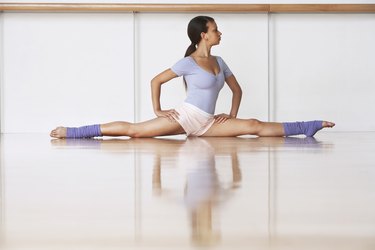
A typical ballet class is designed to help students perfect their postural alignment, increase muscle and joint flexibility and build essential muscular strength. Ballet technique is extremely demanding physically, and dancers learn to identify and engage certain muscles as they work through a logical series of exercises at the ballet barre and in the center of the room. As a result of frequent and consistent training in these exercises, ballet dancers typically develop significant strength in several key muscle groups.
Quadriceps and Hamstrings
Video of the Day
Ballet dancers appreciate the aesthetic quality of a straight leg line, so they work hard to consistently achieve long and high leg extensions. As a result, dancers typically develop strong quadriceps, the muscles that assist with full knee extension and hip flexion. At the same time, dancers understand the functional advantage of deep knee bends. The plie – or knee bend – is a fundamental move in ballet, and every time a dancer bends her knees into plie, her hamstrings contract. Consequently, a dancer's hamstrings become increasingly strong and powerful as she progresses in her training.
Video of the Day
Hip and Gluteal Muscles
Turnout of the legs at the hip socket is a key element of classical ballet technique. Dancers use their external hip rotator and gluteal muscles to rotate their legs outward and to sustain that rotation during leg extensions, leaps and turns. Ballet trainees learn to engage these muscles regularly to maintain their turnout, whether they are standing in basic first position at the barre, holding a difficult pose, pushing off from the floor in a jump or traveling across the floor. With consistent effort, dancers who work to increase their turnout develop strong external rotator and gluteal muscles.
Calves and Feet
Ballet dancers strengthen the muscles of their lower legs and feet every time they point or rise onto their toes. Exercises at the barre that emphasize plantar flexion require a dancer to engage her calf muscles and work slowly and deliberately through her feet, using the floor as resistance. When she jumps, she uses the same technique of pushing hard against the floor to propel herself upward, and when she lands, she takes care to articulate through her feet to soften her landing. The result of such footwork is that she builds significant muscle strength in her calves and feet.
Back and Core
Ballet dancers rely heavily on their abdominal, back and pelvic muscles to provide essential stability. They train themselves to keep those muscles engaged throughout every pose, turn, leap and jump. Tightening her core muscles helps a dancer maintain proper alignment and balance, ensures that her movement quality is clean and powerful, frees up her extremities and provides some protection from dance-related injury. Ballet dancers activate their core muscles continually -- both at the ballet barre and in the center -- so these muscles become tight and strong.